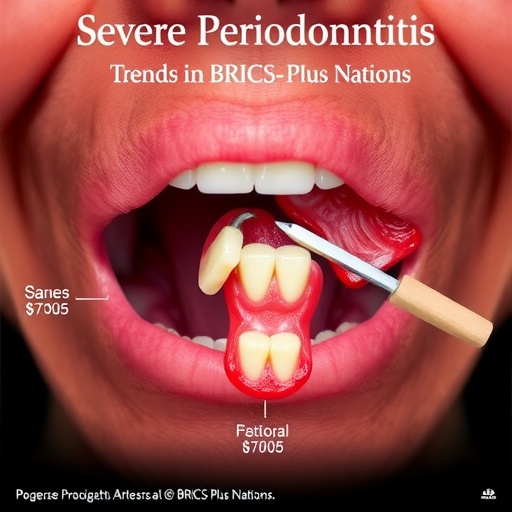Emerging Patterns and Future Projections of Severe Periodontitis in BRICS-Plus Nations: An In-depth Analysis
Severe periodontitis, a chronic inflammatory disease affecting the supporting structures of the teeth, presents a significant public health concern worldwide due to its association with systemic conditions and its impact on quality of life. Recent comprehensive research has delved into the burden and forecast of this debilitating disease across BRICS-Plus countries from 1990 to 2040, elucidating alarming trends that demand immediate scientific and policy attention. The implications of these findings extend beyond dental health, underscoring the intricate interplay between socioeconomic development, healthcare infrastructure, and population aging.
The BRICS-Plus consortium encompasses a diverse set of low- and middle-income nations characterized by varying healthcare capabilities and demographic profiles. By focusing on these countries, the study captures a heterogenous population segment that contributes substantially to the global disease burden. Using longitudinal data analytics derived from the Global Burden of Disease Study framework, researchers have unpacked prevalence rates, disability-adjusted life years (DALYs), and predicted incidence trajectories, revealing nuanced inter-country disparities and temporal patterns.
In the early 1990s, the incidence of severe periodontitis in these nations exhibited heterogeneous baselines influenced by regional socioeconomic factors, urbanization levels, and healthcare accessibility. Notably, countries such as India and South Africa demonstrated higher baseline prevalence, potentially attributable to disparities in public health initiatives and dental care utilization. The study highlights that over three decades, the absolute number of affected individuals has surged, driven primarily by population growth and the demographic transition towards an aging populace more susceptible to chronic oral diseases.
Forecast models projecting up to 2040 articulate a continued upward trend in severe periodontitis burden, with some nations anticipated to experience exponential increases. This projection raises critical questions about the preparedness of existing healthcare systems to manage the rising tide of oral diseases. The interplay between periodontitis and systemic health — including cardiovascular diseases, diabetes mellitus, and adverse pregnancy outcomes — underscores the urgency of integrating oral health into broader public health frameworks.
Methodologically, the investigation employed advanced Bayesian meta-regression techniques, incorporating covariates such as smoking prevalence, diabetes incidence, and socioeconomic status to refine accuracy. The analytical rigor provides a robust foundation for policy formulation, enabling targeted interventions that address underlying determinants beyond mere clinical management. This multidimensional approach is particularly salient given the limited dental health workforce and resources characteristic of many BRICS-Plus nations.
The temporal analysis accentuates a disconcerting trend: while age-standardized incidence rates might appear stable or even declining in some countries due to improved health literacy and preventive efforts, the absolute disease burden continues to escalate. This paradox results from demographic shifts where increasing life expectancy translates to more individuals reaching ages prone to periodontitis onset and progression, thereby elevating total morbidity.
Intervention strategies underscore the necessity for multisectoral collaboration encompassing healthcare providers, policymakers, and community stakeholders. Amplifying public awareness campaigns, bolstering primary healthcare infrastructure with dental services, and integrating periodontitis screening into routine medical examinations constitute pivotal steps forward. Additionally, addressing modifiable risk factors such as tobacco use, poor glycemic control, and inadequate oral hygiene remains vital in curtailing disease progression.
The study’s granular country-level forecasts offer unparalleled insights into where resource allocation and preventive measures can be optimized. For instance, certain nations poised for steep increases in case numbers necessitate urgent scaling of dental public health programs. Conversely, countries exhibiting plateaued or declining trends might benefit from sustaining and amplifying current successful interventions.
Scientifically, these findings stimulate further inquiry into genetic and environmental determinants of periodontitis susceptibility within diverse populations. The heterogeneity observed calls for region-specific research to delineate pathogen-host interactions, microbial ecology shifts, and immune response variability. Advances in molecular diagnostics and personalized dental medicine could hold transformative potential in reversing disease trajectories identified herein.
Furthermore, the interconnection between socioeconomic inequities and oral health outcomes unveiled by this research reinforces the broader narrative of health disparities. Periodontitis disproportionately affects socioeconomically disadvantaged groups, exacerbating health inequity. Policy efforts informed by this evidence must prioritize equity-informed resource distribution to bridge these gaps effectively.
In extrapolating to global health implications, severe periodontitis serves as a sentinel marker of systemic health and healthcare system robustness. The escalating burden in BRICS-Plus countries signals potential future challenges in other transitioning economies, necessitating preemptive adoption of integrated oral-systemic healthcare paradigms. The cross-disciplinary potential of this research lies in its capacity to inform global non-communicable disease frameworks, embedding oral health as a core component.
Concomitantly, the study underscores the vital role of epidemiological monitoring and surveillance in chronic disease management. The blending of contemporary data analytics with traditional epidemiology paves a new path for dynamic forecasting models that can adapt to evolving demographic and environmental contexts. Such tools empower decision-makers with anticipatory knowledge indispensable for resilient health system planning.
Ultimately, mitigating the escalating burden of severe periodontitis within BRICS-Plus nations demands a synthesis of scientific innovation, robust public health strategies, and socio-political commitment. This research represents a watershed moment in conceptualizing oral health within the fabric of global health, urging the integration of dental medicine into the broader canvas of chronic disease prevention and management over the coming decades.
Subject of Research:
The study investigates the temporal trends and future projections of the burden of severe periodontitis in BRICS-Plus nations from 1990 to 2040, analyzing epidemiological data to understand disease prevalence, incidence, and associated health impacts within these emerging economies.
Article Title:
Burden and forecast of severe periodontitis in BRICS-Plus nations: trends from 1990 to 2040.
Article References:
Luo, LS., Huang, J., Luan, HH. et al. Burden and forecast of severe periodontitis in BRICS-Plus nations: trends from 1990 to 2040. Int J Equity Health 24, 299 (2025). https://doi.org/10.1186/s12939-025-02660-7
DOI:
https://doi.org/10.1186/s12939-025-02660-7




